外研版九上英语Module 7 说课稿
- 格式:doc
- 大小:16.50 KB
- 文档页数:2
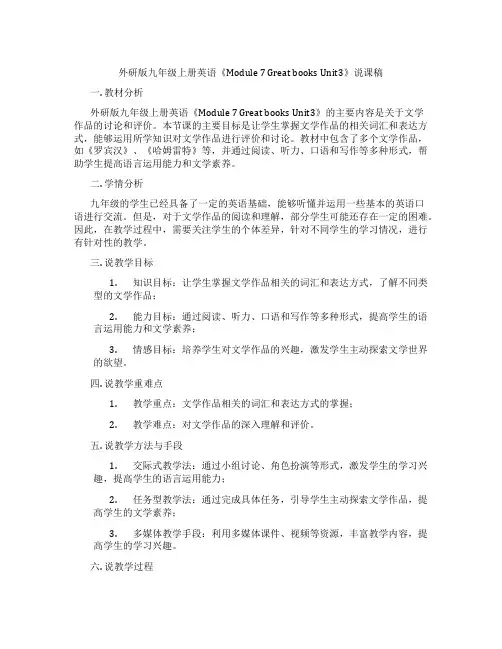
外研版九年级上册英语《Module 7 Great books Unit3》说课稿一. 教材分析外研版九年级上册英语《Module 7 Great books Unit3》的主要内容是关于文学作品的讨论和评价。
本节课的主要目标是让学生掌握文学作品的相关词汇和表达方式,能够运用所学知识对文学作品进行评价和讨论。
教材中包含了多个文学作品,如《罗宾汉》、《哈姆雷特》等,并通过阅读、听力、口语和写作等多种形式,帮助学生提高语言运用能力和文学素养。
二. 学情分析九年级的学生已经具备了一定的英语基础,能够听懂并运用一些基本的英语口语进行交流。
但是,对于文学作品的阅读和理解,部分学生可能还存在一定的困难。
因此,在教学过程中,需要关注学生的个体差异,针对不同学生的学习情况,进行有针对性的教学。
三. 说教学目标1.知识目标:让学生掌握文学作品相关的词汇和表达方式,了解不同类型的文学作品;2.能力目标:通过阅读、听力、口语和写作等多种形式,提高学生的语言运用能力和文学素养;3.情感目标:培养学生对文学作品的兴趣,激发学生主动探索文学世界的欲望。
四. 说教学重难点1.教学重点:文学作品相关的词汇和表达方式的掌握;2.教学难点:对文学作品的深入理解和评价。
五. 说教学方法与手段1.交际式教学法:通过小组讨论、角色扮演等形式,激发学生的学习兴趣,提高学生的语言运用能力;2.任务型教学法:通过完成具体任务,引导学生主动探索文学作品,提高学生的文学素养;3.多媒体教学手段:利用多媒体课件、视频等资源,丰富教学内容,提高学生的学习兴趣。
六. 说教学过程1.导入:通过展示一些著名文学作品的照片或简介,引导学生谈论自己对文学作品的看法,激发学生的学习兴趣;2.新课呈现:通过多媒体课件,展示本节课要学习的文学作品相关词汇和表达方式;3.课堂活动:学生进行小组讨论、角色扮演等形式的交际活动,让学生在实际语境中运用所学知识;4.听力训练:播放与本节课相关的文学作品听力材料,让学生听懂并复述故事内容;5.口语练习:引导学生运用所学词汇和表达方式,进行口语表达和讨论;6.写作任务:布置与本节课相关的写作任务,让学生运用所学知识进行写作;7.总结与拓展:对本节课所学内容进行总结,并提供一些拓展阅读材料,引导学生课后进一步学习。
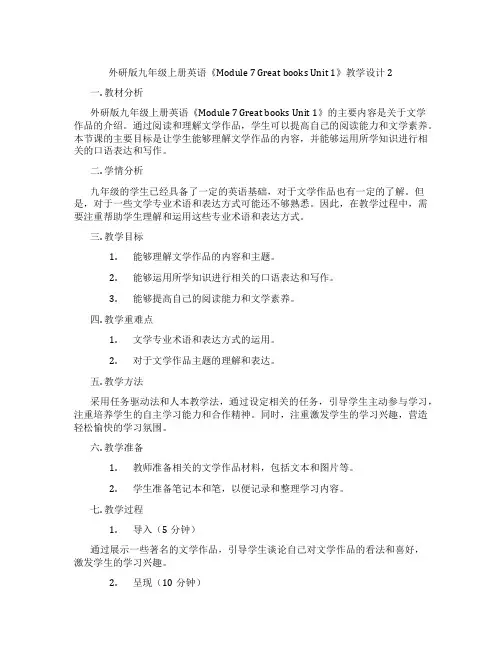
外研版九年级上册英语《Module 7 Great books Unit 1》教学设计2一. 教材分析外研版九年级上册英语《Module 7 Great books Unit 1》的主要内容是关于文学作品的介绍。
通过阅读和理解文学作品,学生可以提高自己的阅读能力和文学素养。
本节课的主要目标是让学生能够理解文学作品的内容,并能够运用所学知识进行相关的口语表达和写作。
二. 学情分析九年级的学生已经具备了一定的英语基础,对于文学作品也有一定的了解。
但是,对于一些文学专业术语和表达方式可能还不够熟悉。
因此,在教学过程中,需要注重帮助学生理解和运用这些专业术语和表达方式。
三. 教学目标1.能够理解文学作品的内容和主题。
2.能够运用所学知识进行相关的口语表达和写作。
3.能够提高自己的阅读能力和文学素养。
四. 教学重难点1.文学专业术语和表达方式的运用。
2.对于文学作品主题的理解和表达。
五. 教学方法采用任务驱动法和人本教学法,通过设定相关的任务,引导学生主动参与学习,注重培养学生的自主学习能力和合作精神。
同时,注重激发学生的学习兴趣,营造轻松愉快的学习氛围。
六. 教学准备1.教师准备相关的文学作品材料,包括文本和图片等。
2.学生准备笔记本和笔,以便记录和整理学习内容。
七. 教学过程1.导入(5分钟)通过展示一些著名的文学作品,引导学生谈论自己对文学作品的看法和喜好,激发学生的学习兴趣。
2.呈现(10分钟)教师展示文学作品的相关材料,包括文本和图片等,引导学生阅读和理解文学作品的内容。
3.操练(10分钟)学生分组讨论,运用所学知识进行相关的口语表达,教师进行指导和评价。
4.巩固(10分钟)学生根据所学内容,进行写作练习,教师进行指导和评价。
5.拓展(10分钟)学生进行小组讨论,探讨文学作品的主题和意义,教师进行指导和评价。
6.小结(5分钟)教师对所学内容进行总结,强调文学作品的的重要性和价值。
7.家庭作业(5分钟)学生根据所学内容,完成相关的家庭作业,巩固所学知识。

Module 7 Great BooksUnit 1 We’re still influenced by Confucius's ideas.单词discuss, thinker, wise, review, influence,4.能够谈论自己喜爱的书籍和作家。
5.掌握一般现在时被动语态的概念和用法。
能够听懂谈论人物或文学作品的对话。
并能在一般现在时的被动语态的用法。
能够通过对话学习,对孔子、莎士比亚、马克吐温这三位伟大的人物有基本的认识,在交流中鼓励不同层次的学生敢于发表自己的观点。
Step 1情景导入T:There are many famous writers and thinkers in the world. How many do you know?S1:Lu Xun is a great writer.T:You\'re right. Who else?S1:Shakespeare is a great writer.T:Do you know Confucius?S2:Yes, I do. He was a teacher, a thinker. He was also a writer.T:Today, we will learn more about them.Step 2完成教材 Activities 1,2的任务1.Work in pairs. Look at the pictures.Say who the people are and why they are famous. Now listen and check your answers. (Activity 1)(1)教师先提供一些词汇,供学生讨论使用。
例如:great, influence, play, poem, respect, story, thinker, thought, wise, writer 等。
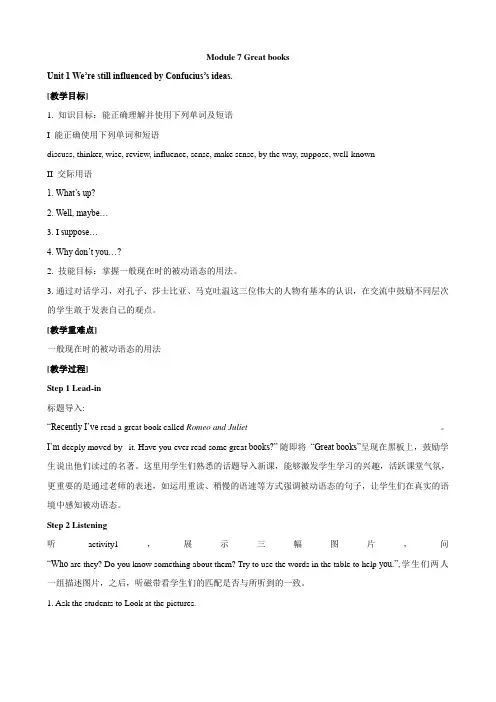
Module 7 Great booksUnit 1 We’re still influenced by Confucius’s ideas.[教学目标]1. 知识目标:能正确理解并使用下列单词及短语I 能正确使用下列单词和短语discuss, thinker, wise, review, influence, sense, make sense, by the way, suppose, well-knownII 交际用语1. What’s up?2. Well, maybe…3. I suppose…4. Why don’t you…?2. 技能目标:掌握一般现在时的被动语态的用法。
3. 通过对话学习,对孔子、莎士比亚、马克吐温这三位伟大的人物有基本的认识,在交流中鼓励不同层次的学生敢于发表自己的观点。
[教学重难点]一般现在时的被动语态的用法[教学过程]Step 1 Lead-in标题导入:“Recently I’ve read a great book called Romeo and Juliet。
I’m deeply moved by it. Have you ever read some great books?”随即将“Great books”呈现在黑板上,鼓励学生说出他们读过的名著。
这里用学生们熟悉的话题导入新课,能够激发学生学习的兴趣,活跃课堂气氛,更重要的是通过老师的表述,如运用重读、稍慢的语速等方式强调被动语态的句子,让学生们在真实的语境中感知被动语态。
Step 2 Listening听activity1,展示三幅图片,问“Who are they? Do you know something about them? Try to use the words in the table to help you.”,学生们两人一组描述图片,之后,听磁带看学生们的匹配是否与所听到的一致。
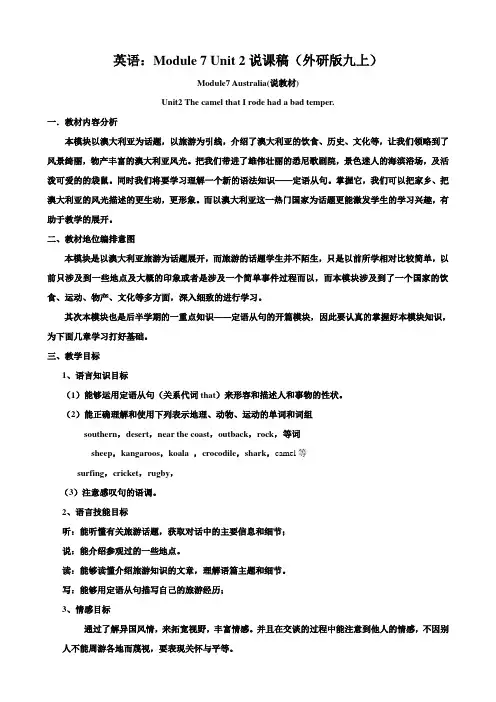
英语:Module 7 Unit 2说课稿(外研版九上)Module7 Australia(说教材)Unit2 The camel that I rode had a bad temper.一.教材内容分析本模块以澳大利亚为话题,以旅游为引线,介绍了澳大利亚的饮食、历史、文化等,让我们领略到了风景绮丽,物产丰富的澳大利亚风光。
把我们带进了雄伟壮丽的悉尼歌剧院,景色迷人的海滨浴场,及活泼可爱的的袋鼠。
同时我们将要学习理解一个新的语法知识——定语从句。
掌握它,我们可以把家乡、把澳大利亚的风光描述的更生动,更形象。
而以澳大利亚这一热门国家为话题更能激发学生的学习兴趣,有助于教学的展开。
二、教材地位编排意图本模块是以澳大利亚旅游为话题展开,而旅游的话题学生并不陌生,只是以前所学相对比较简单,以前只涉及到一些地点及大概的印象或者是涉及一个简单事件过程而以,而本模块涉及到了一个国家的饮食、运动、物产、文化等多方面,深入细致的进行学习。
其次本模块也是后半学期的一重点知识——定语从句的开篇模块,因此要认真的掌握好本模块知识,为下面几章学习打好基础。
三、教学目标1、语言知识目标(1)能够运用定语从句(关系代词that)来形容和描述人和事物的性状。
(2)能正确理解和使用下列表示地理、动物、运动的单词和词组southern,desert,near the coast,outback,rock,等词sheep,kangaroos,koala ,crocodile,shark,camel等surfing,cricket,rugby,(3)注意感叹句的语调。
2、语言技能目标听:能听懂有关旅游话题,获取对话中的主要信息和细节;说:能介绍参观过的一些地点。
读:能够读懂介绍旅游知识的文章,理解语篇主题和细节。
写:能够用定语从句描写自己的旅游经历;3、情感目标通过了解异国风情,来拓宽视野,丰富情感。
并且在交谈的过程中能注意到他人的情感,不因别人不能周游各地而蔑视,要表现关怀与平等。
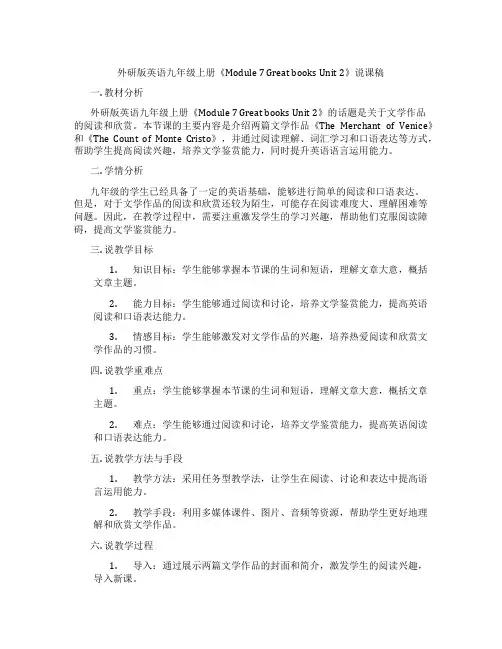
外研版英语九年级上册《Module 7 Great books Unit 2》说课稿一. 教材分析外研版英语九年级上册《Module 7 Great books Unit 2》的话题是关于文学作品的阅读和欣赏。
本节课的主要内容是介绍两篇文学作品《The Merchant of Venice》和《The Count of Monte Cristo》,并通过阅读理解、词汇学习和口语表达等方式,帮助学生提高阅读兴趣,培养文学鉴赏能力,同时提升英语语言运用能力。
二. 学情分析九年级的学生已经具备了一定的英语基础,能够进行简单的阅读和口语表达。
但是,对于文学作品的阅读和欣赏还较为陌生,可能存在阅读难度大、理解困难等问题。
因此,在教学过程中,需要注重激发学生的学习兴趣,帮助他们克服阅读障碍,提高文学鉴赏能力。
三. 说教学目标1.知识目标:学生能够掌握本节课的生词和短语,理解文章大意,概括文章主题。
2.能力目标:学生能够通过阅读和讨论,培养文学鉴赏能力,提高英语阅读和口语表达能力。
3.情感目标:学生能够激发对文学作品的兴趣,培养热爱阅读和欣赏文学作品的习惯。
四. 说教学重难点1.重点:学生能够掌握本节课的生词和短语,理解文章大意,概括文章主题。
2.难点:学生能够通过阅读和讨论,培养文学鉴赏能力,提高英语阅读和口语表达能力。
五. 说教学方法与手段1.教学方法:采用任务型教学法,让学生在阅读、讨论和表达中提高语言运用能力。
2.教学手段:利用多媒体课件、图片、音频等资源,帮助学生更好地理解和欣赏文学作品。
六. 说教学过程1.导入:通过展示两篇文学作品的封面和简介,激发学生的阅读兴趣,导入新课。
2.阅读理解:学生自主阅读课文,回答相关问题,教师给予引导和帮助。
3.词汇学习:学生学习和掌握本节课的生词和短语,教师通过例句和练习帮助学生巩固。
4.文学鉴赏:学生分组讨论,分享对文学作品的看法和感受,教师给予评价和指导。
5.口语表达:学生进行角色扮演,模拟文学作品中的场景,提高口语表达能力。
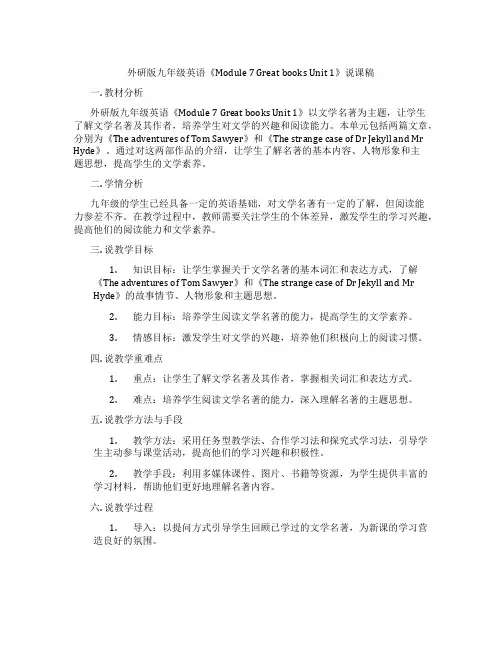
外研版九年级英语《Module 7 Great books Unit 1》说课稿一. 教材分析外研版九年级英语《Module 7 Great books Unit 1》以文学名著为主题,让学生了解文学名著及其作者,培养学生对文学的兴趣和阅读能力。
本单元包括两篇文章,分别为《The adventures of Tom Sawyer》和《The strange case of Dr Jekyll and Mr Hyde》。
通过对这两部作品的介绍,让学生了解名著的基本内容、人物形象和主题思想,提高学生的文学素养。
二. 学情分析九年级的学生已经具备一定的英语基础,对文学名著有一定的了解,但阅读能力参差不齐。
在教学过程中,教师需要关注学生的个体差异,激发学生的学习兴趣,提高他们的阅读能力和文学素养。
三. 说教学目标1.知识目标:让学生掌握关于文学名著的基本词汇和表达方式,了解《The adventures of Tom Sawyer》和《The strange case of Dr Jekyll and MrHyde》的故事情节、人物形象和主题思想。
2.能力目标:培养学生阅读文学名著的能力,提高学生的文学素养。
3.情感目标:激发学生对文学的兴趣,培养他们积极向上的阅读习惯。
四. 说教学重难点1.重点:让学生了解文学名著及其作者,掌握相关词汇和表达方式。
2.难点:培养学生阅读文学名著的能力,深入理解名著的主题思想。
五. 说教学方法与手段1.教学方法:采用任务型教学法、合作学习法和探究式学习法,引导学生主动参与课堂活动,提高他们的学习兴趣和积极性。
2.教学手段:利用多媒体课件、图片、书籍等资源,为学生提供丰富的学习材料,帮助他们更好地理解名著内容。
六. 说教学过程1.导入:以提问方式引导学生回顾已学过的文学名著,为新课的学习营造良好的氛围。
2.呈现:介绍《The adventures of Tom Sawyer》和《The strange caseof Dr Jekyll and Mr Hyde》这两部作品,让学生了解作者、故事情节和人物形象。
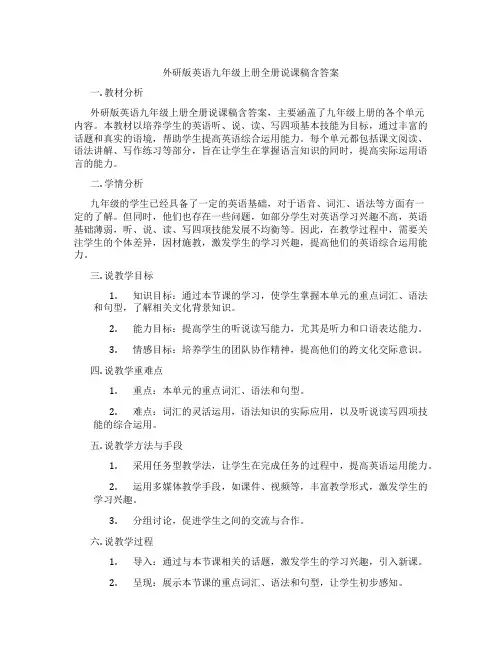
外研版英语九年级上册全册说课稿含答案一. 教材分析外研版英语九年级上册全册说课稿含答案,主要涵盖了九年级上册的各个单元内容。
本教材以培养学生的英语听、说、读、写四项基本技能为目标,通过丰富的话题和真实的语境,帮助学生提高英语综合运用能力。
每个单元都包括课文阅读、语法讲解、写作练习等部分,旨在让学生在掌握语言知识的同时,提高实际运用语言的能力。
二. 学情分析九年级的学生已经具备了一定的英语基础,对于语音、词汇、语法等方面有一定的了解。
但同时,他们也存在一些问题,如部分学生对英语学习兴趣不高,英语基础薄弱,听、说、读、写四项技能发展不均衡等。
因此,在教学过程中,需要关注学生的个体差异,因材施教,激发学生的学习兴趣,提高他们的英语综合运用能力。
三. 说教学目标1.知识目标:通过本节课的学习,使学生掌握本单元的重点词汇、语法和句型,了解相关文化背景知识。
2.能力目标:提高学生的听说读写能力,尤其是听力和口语表达能力。
3.情感目标:培养学生的团队协作精神,提高他们的跨文化交际意识。
四. 说教学重难点1.重点:本单元的重点词汇、语法和句型。
2.难点:词汇的灵活运用,语法知识的实际应用,以及听说读写四项技能的综合运用。
五. 说教学方法与手段1.采用任务型教学法,让学生在完成任务的过程中,提高英语运用能力。
2.运用多媒体教学手段,如课件、视频等,丰富教学形式,激发学生的学习兴趣。
3.分组讨论,促进学生之间的交流与合作。
六. 说教学过程1.导入:通过与本节课相关的话题,激发学生的学习兴趣,引入新课。
2.呈现:展示本节课的重点词汇、语法和句型,让学生初步感知。
3.操练:通过各种教学活动,如角色扮演、小组讨论等,让学生在实际语境中运用所学知识。
4.巩固:通过练习题、游戏等方式,巩固所学知识。
5.拓展:拓展相关话题,提高学生的跨文化交际能力。
6.总结:对本节课的主要内容进行总结,强调重点。
7.作业布置:布置适量作业,让学生课后巩固所学知识。
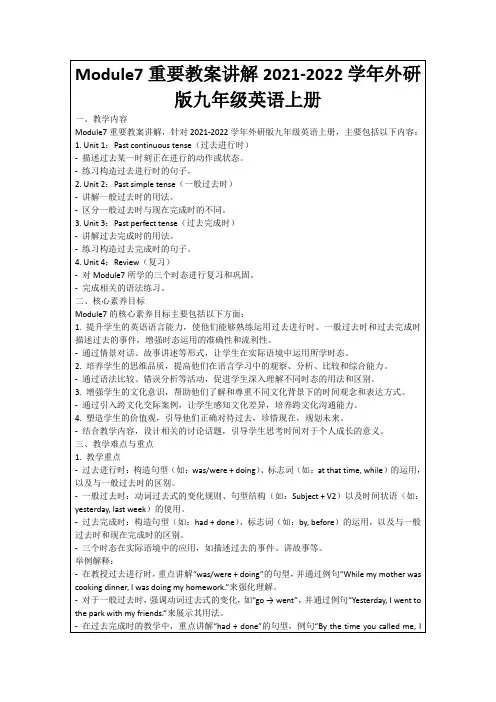
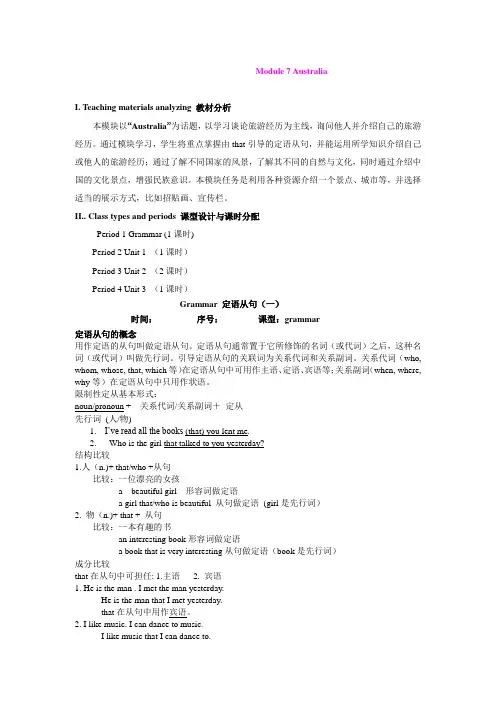
Module 7 AustraliaI. Teaching materials analyzing 教材分析本模块以“Australia”为话题,以学习谈论旅游经历为主线,询问他人并介绍自己的旅游经历。
通过模块学习,学生将重点掌握由that引导的定语从句,并能运用所学知识介绍自己或他人的旅游经历;通过了解不同国家的风景,了解其不同的自然与文化,同时通过介绍中国的文化景点,增强民族意识。
本模块任务是利用各种资源介绍一个景点、城市等,并选择适当的展示方式,比如招贴画、宣传栏。
II.. Class types and periods 课型设计与课时分配Period 1 Grammar (1课时)Period 2 Unit 1 (1课时)Period 3 Unit 2 (2课时)Period 4 Unit 3 (1课时)Grammar 定语从句(一)时间:序号:课型:grammar定语从句的概念用作定语的从句叫做定语从句。
定语从句通常置于它所修饰的名词(或代词)之后,这种名词(或代词)叫做先行词。
引导定语从句的关联词为关系代词和关系副词。
关系代词(who, whom, whose, that, which等)在定语从句中可用作主语、定语、宾语等;关系副词(when, where, why等)在定语从句中只用作状语。
限制性定从基本形式:noun/pronoun + 关系代词/关系副词+定从先行词(人/物)1.I‟ve read all the books (that) you lent me.2.Who is the girl that talked to you yesterday?结构比较1.人(n.)+ that/who +从句比较:一位漂亮的女孩a beautiful girl 形容词做定语a girl that/who is beautiful 从句做定语(girl是先行词)2. 物(n.)+ that + 从句比较:一本有趣的书an interesting book形容词做定语a book that is very interesting从句做定语(book是先行词)成分比较that在从句中可担任: 1.主语 2. 宾语1. He is the man . I met the man yesterday.He is the man that I met yesterday.that在从句中用作宾语。
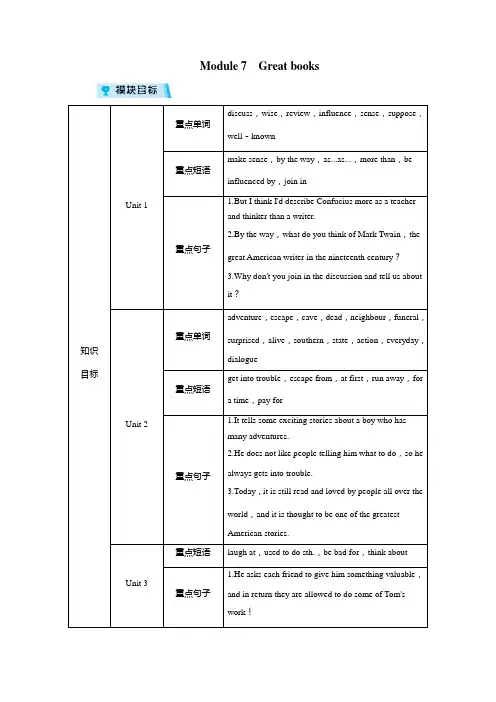
外研版九年级英语上Module7...第一篇:外研版九年级英语上Module7Great books unit 1We“re still influenced by Confucius”s ideas.[定稿]Module7 Great books Unit1 we’re still influenced by Confucious’s ideas.学案学习目标一、知识目标正确使用以下单词、短语交际用语及句子⌝单词、短语:discuss,works,thinker,wise,influence,make sense,by the way,suppose,well-known ⌝交际用语:(1)what’s up?(2)well,maybe(3)I suppose(4)why don’t you ⌝句子(1)We’re still influenced by Confucius’s ideas.(2)Their works are still read by many people today.二、语法目标一般现在时的被动语态(is,am,are+done)学习过程:一.课前延伸: Read the new words before class 二.课内探究 Step 1 Lead inLook at the pictures.Say who the people are.Step 2 Listening1.Listen and complete 1).Confucius is well-known in_____________.2).Shakespear wrote____________________.3).Mark-Twain’s stories are set____________of the US.Step 3 Listen and read.1.Listen to the conversation and match the people with the descriptions.(P57)2.listen again and check True or False 1).Both Betty and Mr Jackson think that Confucius and Shakespeare are great writers.2).Confucius and Shakespeare lived hundreds ofyears ago, so people are influenced little by them now.3).Mr Jackson thinks Mark Twain is as great as Confucius.4).Betty wants Mr Jackson to join the Internet group to discuss great books.3.Read the conversation and answer: 1).What does Betty want to do?2).Does Mr Jackson agree with Betty about the great books?3).Why does Mr Jackson think Confucius and Shakespeareare great?4).What does Betty think of Mark-Twain?5).Who wrote The Adventures of Tom Sawyer?6).Are Mark-Twain’s books still popular?4.Read again and complete: 1).what’s up?中文是____________,表达同样的意思还可以_____________________表达。
九上Module 7 Great booksUnit1 We’re still influenced by Confucius ideas. Teaching aims1.Knowledge objective:Students will be able to master the useful words and structures.Key words: discuss, thinker, wise, review, influence, sense, makesense, by the way, suppose, well-knownkey structures: ----am/is/are done2.Ability objective: To help students to understand conversations aboutliterature works3.Moral objective:To help students know how to share ideas aboutliterature works with classmates4.Important pointsThe new words and expressions.Difficult points:How to use the present tense.passive voice .5.Teaching methods: PWP method, task-based method and interactive approachTeaching proceduresStep 1 Warming-upLet’s discuss:What do you know about him?( Show some pictures of thethree famous persons).Step 2 Pre-task(1). Task: Check the new words.1.Show some pictures and things to get the students say out the new words.anize the students to read the new words together.Step 3 While-taskTask1:Listening(1). Play the tape, ask students to listen and complete the sentences, then check.(Activity 2)(2).Guide the students to listen to the conversation in Activity 3. Questions: Who are Betty’s great writers?What’s Mark Twain’s great book?Task 2: Reading(1) Organize the students to read the conversation with the video then read it together.(2) Organize the students to match the people with the descriptions,thencheck their answers one by one.Task 3: Retell the dialogue(1)Ask students to complete the passage.(Activity 4)(2)Ask two of the students to retell the dialogue.Step 4 Post-taskTask:Do some speakingSay something about your great writer1 Who is your great writer?2 Why do you like him\her?3 What did he\she write?4 What do you think of the book\play…?…Step 5 Summary1.Get the students to sum up the language points.T: What have we learned today?Ss:……Step 6 Homework1. Finish Exercise book M7U1.2. Search for some information about The Adventures of Tom Sawyer.板书设计:Module7 Great booksUnit1 We’re still influenced by Confucius ideas小组评价I accept…T1 T2 T3I agree/don’t agree with…I suppose…I think…。
Module 7 Great books Unit 1 教案We’re still influenced by Confucius’s ideas学习目标:知识目标:1.掌握四会单词短语。
2. 一般现在时的被动语态。
能力目标:能用所学词汇句型进行有关人物的情景对话情感目标:通过本单元学习,使学生能够热爱祖国学习重点:一般现在时的被动语态难点:运用所学语言知识进行有关人物方面的口语交际学习步骤:一.交流检查交流检查课前预习情况,生生、师生互动共同探讨解决预习中存在的问题。
1. 复习本单元重点单词短语,2. 默写几个重点短语。
3. Ask“What do you think of Confucius?”“What do you know about Shakespeare?”二.L istening1. For activity2, listen to the tape for the first time(感知)2. Listen for the second time, and complete the sentences in activity2.三.自主学习。
1. Read the dialogue and match the people with the description:2. Listen and repeat.2.Read aloud for about 5minutes.3.Read the dialogue and complete the passage with the correct form of the words in the box.Mr Jackson and Betty are __________ great writers. Betty explains that in her Internet group, each person reads a favourite book and then writes a(n) _______ of it. Mr Jackson ________ that Confucius and Shakespeare are great because their works are still read by people today, but he thinks Confucius was more a teacher and ________ than a writer. He says that Confucius was a very _______ man. Mr Jackson thinks that we are still_________by Confucius’ideas and that Shakespeare’s plays still make _______ to people today.5. Work in groupsDo you agree the following opinions?Give your reasons.1.Teahouse is one of the greatest pieces of Chinese writing?2. Everyone should learn some Tang poems.3. We should only read books by great writers.omplete the passage.四.交流展示。
教学设计课题名称:Module 7 Great booksUnit1 We’re still influenced by Confucius’s ideas.课时情况:第 1 、2课时,共 5 课时ⅠTeaching modelListening and speakingⅠTeaching methodPWP, task-based approachⅠTeaching aims1. To be able to understand conversations about great books2. To be able to talk about your favourite books, plays and writersⅠTeaching ObjectivesⅠTeaching aidsTape recorder, OHP, videoⅠTeaching StepsStep1. Warming up and lead-inShow the play Teahouse and answer:1. The play is called …2. It was written by …3. He is considered …4. It was made into film …Step2. Presentation1. Present four great classical novels in China one by one and guide Ss to answer following questions:If some questions are too difficult to answer, T can choose some of them.Step3. Pair workSs have a pair work to talk about four great classical novels as following:A: I think they are masterpieces of Chinese literature. What do you think of them?B: I agree / don’t agree with…I suppose / think that…I accept(承认) that they make a great sense to us…Step4. Listening1. Show some other books and ask Ss to guess the writers2. Listen and complete the sentences in Activity 2.Step5. Listening and reading1. Listen and answer the questions:2. Read and match the people with the descriptions in Activity3.3. Find out the sentences to show opinions.4. Complete the passage with the correct form of the words in the box in Activity 4.\ Step6. Pronunciation and speakingListen and underline the words the speaker stresses.1. We’re still influenced by Confucius’s ideas.2. Shakespeare’s plays also make a lot of sense to us today.3. He was important, but I suppose he isn’t as well-known as Confucius or Shakespeare. Step7. SummarySummarize the key vocabulary and structures.HomeworkBlackboard DesignUnit 1We’re still influenced by Confucius’s ideas. Teaching reflection教学设计课题名称:Module 7 Great booksUnit 2 It is still read and loved.课时情况:第 3 、4课时,共 5 课时ⅠTeaching modelReading and writing.ⅠTeaching methodInteractive approach; task-based approachⅠ Teaching aims1. To be able to transfer information from a passage to a table2. To be able to write about a favourite bookⅠ Teaching Objectives1. Key vocabulary ---get into trouble, run away, escape, dead, for a time, neighbour, surprised,alive, southern, state, pay for, action, everyday2. Key structures --- It is written in everyday English.It is still read and loved by people all over the world.It is thought to be one of the greatest American stories.Ⅰ Teaching aidsRecorder, OHP, videoⅠTeaching StepsStep 1 Review and lead-in1. Ask Ss what books they have read and talk about Ss’ favourite books as following:2. Discuss with Ss why it is important to read great books?It makes people… It helps people… It can teach people…Step 2 Reading1. Before Reading2. General reading: Match the main idea with paragraphs.3. Careful reading(1) Read Para 1 and answer the questions.(2) Read Para 2 and answer.(3) Read Para 3 and choose the correct meanings.Read Para 3 and answer.(4) Read Para 4 and check T or F.4. After readingComplete the passage with the correct form of the words in the box in Activity 4.5. RetellingGuide Ss to retell the passage with the help of some pictures.Step 3 Writing.1. Work in pairs. Ask and answer the question in Activity 5.2. Complete the column in the table in Activity3.3. Work in pairs. Talk about Ss’ favourite book.4. Write a passage about Ss’ favourite book.Homework:Blackboard Design:Unit 2 It is still read and loved. Teaching reflection教学设计课题名称:Module 7 Great booksUnit 3 Language in use课时情况:第5课时,共 5 课时ⅠTeaching modelRevision and applicationⅠTeaching methodFormal and interactive practiceⅠTeaching aims1. To summarise and consolidate the use of present passive voice2. To organize a class talkⅠTeaching ObjectivesGrasp how to use six basic tenses correctlyⅠTeaching aidsTape recorder, OHP, handoutsⅠTeaching StepsStep 1 RevisionTalk about Ss’ hobbies to review the text of Unit 1 and Unit 2.Step 2 Language practice1. Read through the example sentences in the box with the whole class.2. Ask the students to finish sentences with present passive voice. Step 3 Exercise1. Ask Ss to read the sentences in Activity 1.2. Then complete the sentences.3. Check the answers.Step 4 Complete the passage1. Ask Ss to finish the passage in Activity2.2. Check the answers and read the passage.Step 5 Complete the conversation1. Ask Ss to finish the conversation in Activity 3.2. Ask several pairs to read to check the answers.Step 6 Complete the conversation with the words in the box.1. Ask Ss to finish the conversation in Activity 4.2. Ask several pairs to read to check the answers.Step 7 Complete the conversation with the correct form in the box.1. Ask Ss to finish the conversation in Activity 5.2. Ask several pairs to read to check the answers.Step 8 Listening1. Talk about the books in Activity 6.Step 9 Around the world: Plato and The Republic1. Ask the students to talk about Plato and his works.2. Read through the passage to know more about Plato.Step 10 Module task: Organising a class talk Homework:Blackboard Design:Unit 3 Language in use Teaching reflection。
Module 7 Great books【教材分析】本模块的话题是围绕名人、名著展开的。
学生对本模块的知识有一定的基础认知,教师应该抓住这一契机,最大限度的结合学生已有的知识开展教学活动,从而帮助学生提高语言能力和文化素养。
本模块围绕谈论名人、名著开始听、说、读、写教学活动,其中涉及到的三位名人——孔子、莎士比亚和马克·吐温都是学生比较熟悉的。
教师可让学生提前查找相关资料,了解名人的国籍、所处年代、主要思想以及代表作等细节信息。
本模块的语法项目是一般现在时的被动语态,学生掌握它的基本概念和用法。
教师可以根据平时的实际情况,开展真实的情境教学,帮助学生更好地理解这一抽象的语法现象。
Unit 1 We’re still influenced by Confucius’s idea.一、教学目标:●Knowledge objective理解discuss, wise, review, influence, sense, suppose, well-known, make sense, by the way在文中的意思,能正确的识记并能用它们造句。
●Ability objective1. 能够辨认并掌握句子重音;2. 能够听懂谈论人物或文学作品的对话;3. 能够谈论自己喜爱的文学作品;4. 掌握一般现在时的被动语态的概念和用法。
●Moral objective通过学习,树立好读书、多读书、读好书的意识,通过读书,不断丰富自己的学识。
二、教学方法Interactive approach method, task-based method三、读前导入Warming-up教师搜集一些名人的图片,和学生一起谈论他们的作品,对他们的评价等,激发学生们的学习兴趣。
四、教学过程Step 1 Lead-in1. Ask the students some questions. Do you like reading books? What’s your favourite book? Who’syour favourite writer?2.Work in pairs. Show three pictures about Confucius,Shakespeare and Mark Twain. Let them guess who they are. Can you say something about them?Step 2小听力Listening(自主完成,合作释疑)一层听:Listen and check your answers.1. Confucius was a great teacher and thinker in ancient China.2. William Shakespeare wrote plays and poems about 400 years ago, but people still can see his plays and read his poems.3. Mark Twain was an American writer and his works are studied in schools.二层听:Listen again and complete the sentences.1. Confucius is well-known in__________.2. Shakespeare wrote __________.3. Mark Twain’s stories are set _________ of the U S.Step 3 New words1. 朗读单词Words: discuss, wise, review, influence, sense, suppose, well-known, make sense, by the way,注意单词中每个音节的发音和字母组合。
外研版九上英语各位评委老师:
大家上午好!今天我说课的题目是:
Module 7 Great books Unit 1We’re still influenced by Confucius’s ideas.
首先利用多媒体课件展示本节课的课题,同时通过孔子的图片让学生初步感知本节课要学习的话题。
教材分析:
本节课是一节听说课,以孔子,莎士比亚和马克吐温为话题进行听说训练。
重难点是一般现在时的被动语态。
学生分析:
学生在Module 1 中复习了一般现在时,在掌握主动语态的基础上学习被动语态,学生较容易接受。
教学目标:
知识目标:
掌握本单元的单词及短语:work n.作品thinker n.思想家literature n.文学influence v.影响respect v.尊重,尊敬wise adj.睿智的monthly adj.每月一次的,每月的as far as就……来说,至于not…any more 不再……millions of数百万的
技能目标:掌握同意和不同意的表达方式。
情感目标:培养同学们热爱读书的习惯,提高自身素质。
教学过程:
课前延伸:在学习本课前,要求学生进行课前读词。
学生以小组为单
位齐读本单元单词。
让学生明确任务的同时利用多媒体课件展示本单元单词,单词以名词,动词,形容词,词组的顺序进行展示,既直观,又便于学生有规律地记忆。
课内探究:本课是一节听说课,我设计了新课导入,听力训练,对话
处理,学以致用四个环节。
一.新课导入
我利用多媒体课件展示了一般现在时的两个句子: Many people read Confucius’ works.(主动语态) Confucius’ works are read by many people.(被动语态)
这两个句子句意是相同的,但第一个是主动语态,第二个是被动语态。
学生通过观察认识被动语态,通过直观的对比,学生总结主动语态与被动语态的不同:主语与宾语位置的变化,谓语结构的变化。
从而导入本节课的新授知识:一般现在时的被动语态 am/is/are + done. 二.听力训练
1. 播放录音前,先展示孔子,莎士比亚,马克吐温的图片及相应的词汇,让学生把图片与词汇进行搭配。
2. 然后播放录音核对答案。
3. 听录音后再次展示图片及词汇检查学生答案。
三.对话处理
对话处理是本节课的主要内容,我设计了以下五个任务: 1.读对话,回答问题。
利用多媒体课件展示问题:
1.Who do you think Mr Jackson is?
2. What was Betty looking for in the library ? Why ?
3. What does Betty think of Mark Twain’s great book is?
4. What is Mr Jackson’s opinion of what a great book is?
学生回答后再次利用多媒体课件展示答案进行检查。
2.听对话,探究重难点。
本节课的重难点是一般现在时的被动语态,学生听的过程中找出其谓语结构:am/is/are done. 听后利用多媒体课件展示答案与学生核对。
然后学生再次读对话,小组合作找重点短语,合作结束后展示老师找出的短语与学生核对,同时点拨be known as 的用法。
3.口语速记。
展示Everyday English,学生速记后抽查效果。
4.完成句子。
利用课件展示句子,学生完成后展示答案检查。
5.朗读。
播放录音,学生跟读,注意停顿。
四.学以致用
1. 利用课件展示下列句子:
•Shakespeare’s plays are seen by millions of people . • Millions of people see Shakespeare’s play s.
• Today it is thought to be one of the greatest books. • Today people think it is one of the greatest books.
•Confucius’ works are still read by many people today. • Many people today still read Confucius’works.
• Many people today still read Confucius’ works.
• Mark Twain isn’t known as a great thinker. • People don’t know Mark Twain as a great thinker. 学生对比观察,总结本节课所学重难点。
2. 针对性训练,课件展示练习题:
grow / isn’t grown punish / is punished influence / are influenced
1.Tom_____________ for fighting.
2.They __________ Tom for fighting.
3.Confucius’ thoughts _________ people.
4.People __________ by Confucius’ thoughts.
5.Farmers ________ rice in spring.
6.Rice ____________ in winter in the north.
学生完成后展示答案核对。
最后小组合作小结:本节课的收获。